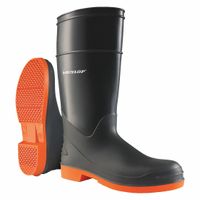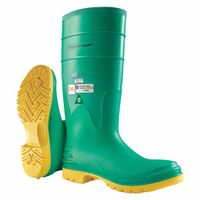Call +(254) 703 030 000 / 751 483 999 / 721 704 777
- Home
- Safety
- Footwear Footwear Accessories
- Rubber Boots Waders
.....Read More
Frequently Asked Questions
What are the best materials for rubber boots to resist chemicals?
The best materials for rubber boots to resist chemicals include:
1. **Nitrile Rubber (NBR):** Known for its excellent resistance to oils, fuels, and certain chemicals, nitrile rubber is a popular choice for chemical-resistant boots. It offers good abrasion resistance and is suitable for environments where exposure to petroleum-based substances is common.
2. **Neoprene:** This synthetic rubber is highly resistant to a wide range of chemicals, including acids, alkalis, and solvents. Neoprene boots are flexible and provide good insulation, making them suitable for both chemical resistance and comfort in various working conditions.
3. **Polyvinyl Chloride (PVC):** PVC boots are cost-effective and provide good resistance to water, acids, and some chemicals. They are often reinforced with other materials to enhance durability and chemical resistance, making them suitable for less aggressive chemical environments.
4. **Butyl Rubber:** Known for its superior resistance to gases and chemicals, butyl rubber is effective against acids, alkalis, and ketones. It is less permeable to gases, making it ideal for environments with hazardous vapors.
5. **Viton:** A high-performance fluoroelastomer, Viton offers exceptional resistance to a wide range of chemicals, including hydrocarbons, acids, and solvents. It is suitable for extreme chemical environments but is typically more expensive.
6. **Polyurethane (PU):** While not as chemically resistant as some other materials, polyurethane offers good resistance to oils and some chemicals. It is lightweight and durable, making it suitable for environments where chemical exposure is moderate.
When selecting rubber boots for chemical resistance, it is crucial to consider the specific chemicals and concentrations involved, as well as the duration of exposure. Always consult the manufacturer's specifications and safety data sheets to ensure the chosen material meets the necessary safety requirements for your specific application.
How do I choose the right size for rubber boots and waders?
To choose the right size for rubber boots and waders, start by measuring your foot size accurately. Use a ruler or measuring tape to measure the length of your foot from heel to toe. Compare this measurement with the sizing chart provided by the manufacturer, as sizes can vary between brands.
Consider the type of socks you will wear. If you plan to wear thick socks for warmth, you may need to size up to accommodate the extra bulk. Try on the boots or waders with the socks you intend to use to ensure a comfortable fit.
Check the width of the boots. Some brands offer different width options, such as narrow, regular, or wide. Ensure the boots are not too tight or too loose around the widest part of your foot.
For waders, measure your inseam from the crotch to the floor to ensure the waders are long enough. Also, measure your chest and waist to find the right fit, especially if the waders are chest-high. Look for adjustable straps and belts to customize the fit further.
Consider the activity and environment. If you need flexibility and mobility, ensure the boots or waders are not too restrictive. For cold environments, ensure there is enough room for insulation layers.
Finally, read reviews and feedback from other customers regarding sizing and fit, as this can provide insights into whether the product runs true to size, small, or large. If possible, try on different sizes in-store to find the most comfortable fit.
What are the safety features to look for in oil, gas, and mining boots?
When selecting oil, gas, and mining boots, prioritize the following safety features:
1. **Steel Toe Cap**: Essential for protecting feet from heavy falling objects and compression.
2. **Metatarsal Guards**: Offers additional protection to the upper foot area against impacts and crushing.
3. **Puncture-Resistant Soles**: Prevents sharp objects from penetrating the sole, safeguarding the foot.
4. **Slip-Resistant Outsoles**: Provides traction on slippery surfaces, reducing the risk of falls.
5. **Chemical Resistance**: Protects against exposure to hazardous chemicals and oils commonly found in these industries.
6. **Electrical Hazard Protection**: Insulates against electrical shocks, crucial in environments with electrical risks.
7. **Waterproofing**: Keeps feet dry in wet conditions, maintaining comfort and preventing skin issues.
8. **Heat Resistance**: Shields feet from extreme temperatures and hot surfaces.
9. **Ankle Support**: Offers stability and reduces the risk of sprains in uneven terrains.
10. **Comfort and Fit**: Ensures long-term wearability without causing fatigue or blisters.
11. **Breathability**: Allows moisture to escape, keeping feet dry and comfortable.
12. **Reflective Strips**: Enhances visibility in low-light conditions, improving safety.
13. **Durability**: High-quality materials ensure longevity and sustained protection.
14. **Lace-Up or Zipper Closure**: Provides a secure fit and easy removal.
15. **Compliance with Safety Standards**: Ensure boots meet industry-specific safety standards like ASTM or CSA.
These features collectively ensure maximum protection, comfort, and durability in challenging work environments.
How do I maintain and clean rubber boots to ensure longevity?
To maintain and clean rubber boots for longevity, follow these steps:
1. **Regular Cleaning**: After each use, rinse the boots with water to remove dirt and debris. Use a soft brush or cloth to scrub off any stubborn mud or grime. Avoid using harsh chemicals or detergents that can degrade the rubber.
2. **Drying**: Allow the boots to air dry naturally, away from direct sunlight or heat sources like radiators, which can cause the rubber to crack. Stuff the boots with newspaper to absorb moisture and help them retain their shape.
3. **Conditioning**: Apply a rubber conditioner or protectant periodically to keep the material supple and prevent cracking. Use a product specifically designed for rubber boots, following the manufacturer's instructions.
4. **Storage**: Store the boots in a cool, dry place, away from direct sunlight and heat. Keep them upright or hang them to maintain their shape. Avoid folding or creasing the boots, as this can lead to cracks.
5. **Odor Control**: To prevent odors, sprinkle baking soda inside the boots and let it sit overnight. Shake out the excess before wearing. Alternatively, use boot-specific deodorizers.
6. **Inspection and Repair**: Regularly inspect the boots for signs of wear, such as cracks or holes. Small punctures can be repaired with a rubber patch kit. Address any issues promptly to prevent further damage.
7. **Avoid Chemicals**: Keep the boots away from oils, solvents, and other chemicals that can degrade rubber. If exposed, clean them immediately with water.
By following these steps, you can extend the life of your rubber boots and keep them in good condition for years.
Are there specific rubber boots recommended for food-processing environments?
Yes, specific rubber boots are recommended for food-processing environments to ensure safety, hygiene, and comfort. These boots are designed to meet the unique demands of such settings, where cleanliness and protection are paramount. Key features to look for include:
1. **Material**: Boots should be made from high-quality, food-grade rubber or PVC that is resistant to chemicals, oils, and fats commonly found in food-processing areas.
2. **Slip Resistance**: The soles should have a slip-resistant design to prevent falls on wet or greasy surfaces, which are common in food-processing facilities.
3. **Waterproof**: Complete waterproofing is essential to keep feet dry and comfortable, especially in environments where water and other liquids are frequently present.
4. **Easy to Clean**: The boots should have a smooth surface that is easy to clean and sanitize, preventing the buildup of bacteria and contaminants.
5. **Comfort and Fit**: Ergonomic design with cushioned insoles and proper arch support is important for comfort during long shifts. Boots should also be available in various sizes for a proper fit.
6. **Toe Protection**: Steel or composite toe caps may be required to protect against heavy objects or machinery.
7. **Compliance**: Boots should meet industry standards and regulations, such as those set by OSHA or the FDA, for use in food-processing environments.
8. **Antimicrobial Properties**: Some boots come with antimicrobial treatments to further reduce the risk of contamination.
Brands like Dunlop, Tingley, and Servus offer boots specifically designed for food-processing environments, incorporating these features to ensure safety and compliance.
What is the difference between waders and regular rubber boots?
Waders and regular rubber boots are both types of waterproof footwear, but they serve different purposes and have distinct designs.
Waders are designed to provide full-body protection from water. They typically extend from the foot up to the chest or waist, offering coverage for the legs and sometimes the torso. Waders are commonly used in activities like fishing, hunting, and working in wet environments where deeper water is encountered. They are made from materials like neoprene, PVC, or breathable fabrics, and often include features like adjustable suspenders and reinforced knees for added durability and comfort.
Regular rubber boots, on the other hand, are designed to cover only the feet and lower legs, typically reaching up to the knee or just below it. They are suitable for activities where water exposure is limited to shallow depths, such as walking in rain, gardening, or working in muddy conditions. Rubber boots are made from waterproof materials like natural rubber or synthetic alternatives, providing protection against moisture and dirt. They are generally easier to put on and take off compared to waders and are more versatile for everyday use.
In summary, the primary difference lies in the level of coverage and intended use: waders offer full-body protection for deeper water activities, while regular rubber boots provide lower leg protection for shallower, everyday wet conditions.
How do I ensure my feet stay warm in winter, cold-insulated boots?
To ensure your feet stay warm in winter with cold-insulated boots, follow these steps:
1. **Choose the Right Boots**: Select boots with proper insulation, such as Thinsulate or shearling lining, which provide excellent warmth without bulk. Ensure they are waterproof to keep moisture out.
2. **Proper Fit**: Ensure your boots fit well. They should be snug but not tight, allowing room for air circulation and thicker socks. Avoid boots that are too tight, as they can restrict blood flow and reduce warmth.
3. **Layering Socks**: Wear moisture-wicking socks as a base layer to keep feet dry. Add a pair of wool or thermal socks for insulation. Avoid cotton socks, as they retain moisture and can make feet cold.
4. **Foot Warmers**: Use disposable foot warmers or heated insoles for additional warmth. These can be particularly useful in extremely cold conditions.
5. **Keep Feet Dry**: Change socks if they become damp from sweat or snow. Consider using foot powder to absorb moisture and prevent dampness.
6. **Boot Maintenance**: Regularly treat your boots with waterproofing spray to maintain their water resistance. Check for any damage or wear that could compromise insulation.
7. **Warm Up Before Going Out**: Warm your boots indoors before wearing them outside. This can be done by placing them near a heater or using a boot dryer.
8. **Stay Active**: Keep moving to maintain circulation, which helps keep feet warm. Wiggle your toes and flex your feet periodically if standing still for long periods.
9. **Avoid Tight Lacing**: Do not lace your boots too tightly, as this can restrict circulation and lead to cold feet.
By following these steps, you can effectively keep your feet warm and comfortable during the winter months.






